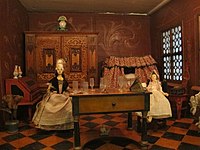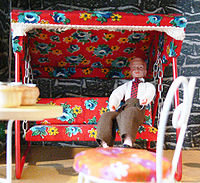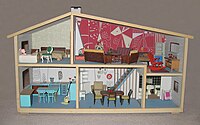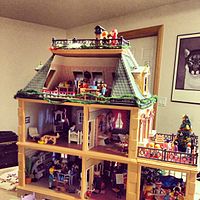Dollhouse

Adollhouseordoll's houseis atoyhouse made inminiature.Since the early 20th century dollhouses have primarily been the domain of children, but their collection and crafting is also ahobbyfor many adults. English-speakers in North America commonly use the termdollhouse,but in theUnited Kingdomand other English-speaking countries the term isdoll's house(or, less commonly,dolls' house).[1]They are often built to putdollsin.
The history of today's dollhouses can be traced back about four hundred years to thebaby housedisplay cases of Europe, which showed idealized interiors. Smaller dollhouses with more realistic exteriors appeared in Europe in the 18th century. Early dollhouses were all handmade, but following theIndustrial RevolutionandWorld War II,they were increasinglymass-producedand became more standardized and affordable. Dollhouses can range from simple boxes stacked together used as rooms for play, to multi-million dollar structures displayed in museums.
Contemporary children's play dollhouses are mostly on a 1:18 (or 2/3 ") scale, while a 1:12 (or 1" ) scale is common for dollhouses made for adult collectors.
History[edit]

Miniature homes, furnished with domestic articles and resident inhabitants, both people and animals, have been made for thousands of years. The earliest known examples were found in theEgyptian tombsof theOld Kingdom,created nearly five thousand years ago. These wooden models of servants, furnishings, boats, livestock and pets placed in the Pyramids almost certainly were made for religious purposes.
The earliest known European dollhouses were thebaby housesfrom the 16th century, which consisted of cabinet display cases made up of individual rooms. The term “baby” in baby house is coined from the old English word meaning doll. Dollhouses of this period showed idealized interiors complete with detailed furnishings and accessories. The cabinets were built by hand with architectural details, filled with miniature household items and were solely intended for adults. The baby moniker referred to the scale of the houses rather than the demographic it was aimed at. They were off-limits to children, not because of safety concerns for the child but to protect the dollhouse. Such cabinet houses[3]were trophy collections owned by the few matrons living in the cities of Holland, England and Germany who were wealthy enough to afford them and, fully furnished, were worth the price of a modest full-size house's construction.

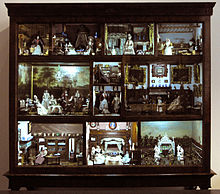
The earliest known recorded baby house was commissioned from 1557-1558 byAlbrecht V, Duke of Bavaria.[4]
Smaller doll houses, such as the Tate house with more realistic exteriors, appeared in Europe in the 18th century.[5]Nuremberg kitchens,a type of single-room dollhouse, date back at least to 1572, when one was given toDorotheaandAnna,the Princesses of Saxony, daughters ofAugustus, Elector of Saxonyaged five and ten.[6]
The early European dollhouses were each unique, constructed on a custom basis by individual craftsmen. With the advent of the Industrial Revolution, factories began mass producing toys, including dollhouses and miniatures suitable for furnishing them. German companies noted for their dollhouses included Christian Hacker,Moritz Gottschalk,Elastolin,and Moritz Reichel. The list of important English companies includes Silber & Fleming, Evans & Cartwright, andLines Brothers(which became Tri-ang). By the end of the 19th century American dollhouses were being made in the United States by The Bliss Manufacturing Company. In France, the Deauville dollhouses were made by the manufacturer Villard & Weill in the first quarter of the 20th century.[7]
Germany produced the most prized dollhouses and doll house miniatures up untilWorld War I.The doll houses were produced inNuremberg, Germany;which, since the sixteenth century, was coined as the 'toy city'. Their baby houses were thought to be the origin for the basic standards of contemporary doll houses.[8]Notable German miniature companies includedMärklin,Rock and Graner and others. Their products were not only avidly collected in Central Europe, but regularly exported to Britain and North America. Germany's involvement in WWI seriously impeded both production and export. New manufacturers arose in other countries.
France produced the dollhouses known as Deauville Dollhouses. They were made by the VILLARD & WEILL company, mainly between 1905 and 1925. This toys manufacturer won prices in Sydney, Paris and St Louis World Fairs.
The TynieToy Company of Providence, Rhode Island, made authentic replicas of American antique houses and furniture in a uniform scale beginning in about 1917.[9]Other American companies of the early 20th century were Roger Williams Toys,Tootsietoy,Schoenhut, and the Wisconsin Toy Co. Dollhouse dolls and miniatures were also produced in Japan, mostly by copying original German designs.
After World War II, dollshouses were mass-produced in factories on a much larger scale with less detailed craftsmanship than before. By the 1950s, the typical dollhouse sold commercially was made of paintedsheet metalfilled with plastic furniture. Such houses cost little enough that the great majority of girls from the developed western countries which were not struggling with rebuilding after World War II could own one.[citation needed]
Standard scales[edit]
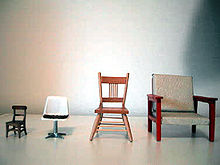
The baby houses of the 17th and 18th centuries, and the toy dollhouses of the 19th and early 20th century rarely had uniform scales, even for the features or contents of any individual house. Although a number of manufacturers made lines of miniature toy furniture in the 19th century, the products were not made to a strict scale.
Children's play dollhouses from most of the 20th and 21st centuries are1:18or two third inch scale (where 1 foot is represented by 2/3 of an inch). Common brands includeLundby(Sweden), Renwal, Plasco,Marx,Petite Princess, and T. Cohn (all American) and Caroline's Home, Barton, Dol-Toi andTri-ang(English). A few brands use 1:16 or 3/4 "-scale.
The most common standard for adult collectors is1:12scale, also called 1 "or one inch scale (where 1 foot is represented by 1 inch.) Among adult collectors there are also smaller scales which are much more common in the United States than in Britain.1:24or half inch scale (1 foot is 1/2 ") was popular in Marx dollhouses in the 1950s but only became widely available in collectible houses after 2002, about the same time that even smaller scales became more popular, like1:48or quarter inch scale (1 foot is 1/4 ") and1:144or "dollhouse for a dollhouse" scale. 1/24th scale dolls houses, and those in smaller scales, may be considered as just one species of miniature houses of this size. 1/24th (or the almost indistinguishable 1/25th) is used for a variety of models including display models and what are coming to be known as 'house portraits'. These typically focus on the exterior detail rather than the rooms inside, though there is no reason why a dolls house should not have a realistic exterior or a house portrait include interior details.
In Germany during the middle part of the 20th century 1:10 scale became popular based onthe metric system.Dollhouses coming out of Germany today remain closer in scale to 1:10 than 1:12.
The largest common size for dollhouses is 1:6 which is proportionate forBarbie,Ken,Blytheand other dolls 11-12 inches tall, and furniture and accessories such asRe-Ment.
Construction[edit]

In the United States, most houses have an open back and a fancy facade, while British houses are more likely to have a hinged front that opens to reveal the rooms.
Children's dollhouses during the 20th century have been made from a variety of materials, including metal (tin litho), fibreboard, plastic, and wood. With the exception ofLundby,1:18 scale furniture for children's dollhouses has most often been made of plastic.
Contemporary kit and fully built houses are typically made ofplywoodormedium-density fiberboard(MDF). Tab-and-slot kits use a thinner plywood and are held together by a system of tabs and slots (plus glue). These houses are usually light-weight and lower cost but often require siding, shingles, or other exterior treatments to look realistic. Kits made from heavier plywood or MDF are held together with nails and glue.
As a hobby[edit]

The dolls house hobby has two main focuses: construction and/or purchase of dolls houses made by or for adult enthusiasts, and collection of contemporary, vintage or antique dolls houses which were often originally made for children.[10][11]
Dolls houses made by or for adult enthusiasts[edit]
Dollhouses for hobbyists and collectors are available in different forms, from ready made and decorated houses to kits to custom built houses made to the customer's design. Some design and build their own dollhouse. Simpler designs might consist of boxes stacked together and used as rooms. Miniature objects used for decoration inside dollhouses includefurniture,interior decorations,dollsand items likebooks,couches, furniture, wallpaper, and evenclocks.Some include functional kitchen appliances to createminiature food.[12]Dollhouses for enthusiasts are available ready made and in kits, but may also be homemade.
Dozens of miniature trade shows are held by various miniature organizations and enthusiasts throughout the year, where artisans and dealers display and sell miniatures. Often, how-to seminars and workshops are part of the show features. Stores that sell miniatures also hold classes. Enthusiasts share images online and use Internet forums, blogs and other online social media to share information about dollhouses and miniatures.
Collection of vintage or antique dolls houses[edit]
Recognition of the value and enjoyment of collecting vintage and antique dolls houses as a hobby is due largely to the publications of two experts,Vivien Greene(1904-2003) in the UK, and Flora Gill Jacobs (1918-2006) in the US. Vivien Greene's first book,English Dolls' Houses of the 18th and 19th Centuries,was published in 1955; in the same year, an exhibition of period dolls houses from several countries was held in London.[13]Flora Gill Jacobs' first book,A History of Dolls’ Houses,was published in 1953.[14]Both collectors opened museums dedicated to dolls houses, the Rotunda (1962-1998) inOxford,England, and the Washington Dolls’ House & Toy Museum (1975-2004),[15]inWashington D.C.,US.
Through print publications such as theInternational Dolls' House News(c 1969-2002)American Miniaturist,andDolls House and Miniature Scene,collectors around the world shared photos, tips, queries and information; today, websites, blogs, social media, and online forums allow even more collectors to share their hobby.
Notable dollhouses[edit]
Anna Köferlin’s (no longer existing) Nuremberg doll house was commissioned in 1631 and was publicly displayed and advertised by Köferlin in the form of original verses composed on broadsheet.[4]
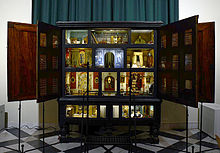
Surviving Dutch 17th century notablecabinetdollhouses include the Amsterdam, Netherlands 18th century dollhouses ofSara Rothé;one is in theFrans Hals Museum,and one is in theGemeentemuseum Den Haag;the dollhouse ofPetronella de la CourtinCentraal Museum,and the dollhouse ofPetronella Oortmanin theRijksmuseum Amsterdam.The Rijksmuseum estimates that Petronella Oortman spent twenty to thirty thousandguilderson her miniature house, which was nearly the price of a real house along one of Amsterdam's canals at that time. All these dollhouses shows the linen room (laundry room), kitchen, and bedrooms in great detail.[3]
InTampereinFinland,theMoomin Museumdisplays theMoomin house,a dollhouse created around theMoomincharacters ofTove Jansson.The house was built by Jansson, Tuulikki Pietilä and Pentti Eistola and later donated to the town of Tampere.[16]The museum also contains dozens of roomboxes with Moomin characters, all made by Tuulikki Pietilä. TheDollhouse Museum(German:Puppenhausmuseum) inBasel,Switzerland is the largest museum of its kind in Europe.
In Russia, the most famousdollhouse[ru]was made forPavel Naschekin[ru](1830s, now in the collection ofNational Pushkin Museum).[citation needed] In the United Kingdom, theUppark Baby-house(ca. 1730) is on exhibit atUppark,West Sussex, owned by The National Trust. TheNostell Priory Baby-house(ca. 1730) is on exhibit atNostell Priory,Yorkshire, also owned by The National Trust.The Tate House(1760) is on exhibit in theMuseum of ChildhoodinLondon, England.[5]

Queen Mary's Dolls' Housewas designed forQueen Maryin 1924 by SirEdwin Lutyens,a leading architect of the time, and is on display atWindsor Castle.[17]When first put on display it was visited by 1.6 million people in seven months.[18]It is approximately 5' tall, contains 16 rooms, and required 4 years to construct. The dollhouse has working plumbing and lights and is filled with miniature items of the finest and most modern goods of the period. Writers likeSir Arthur Conan DoyleandRudyard Kiplingcontributed special books which were written and bound in scale size.[19]
Titania's Palaceis on display inEgeskov CastleinDenmark,a miniature castle that was hand-built by James Hicks & Sons, Irish Cabinet Makers who were commissioned by SirNeville Wilkinsonfrom 1907 to 1922. The palace is 4' 1 "tall, contains 18 rooms, and required 15 years to construct.[20]It was built inIrelandbut was won by Denmark in a bidding war in 1978 at Sotheby's London Auction house.[21]Tara's Palaceis located in theTara's Palace Museum of Childhoodin the grounds ofPowerscourt EstatenearEnniskerry,Ireland.It required 10 years to build, is 4'6 "in height, contains 22 rooms, and was built by Ron McDonnell beginning in 1978 after he failed to secure the return ofTitania's Palaceto Ireland. It is furnished with miniature antiques.[22][23]
TheStettheimer Dollhousewas constructed in New York City by Carrie Walter Stettheimer between 1916 and 1935. Many contemporary artists made miniatures of their art for the dollhouse, includingMarcel Duchamp,Alexander Archipenko,George Bellows,Gaston Lachaise,andMarguerite Zorach.[24][25]It is 28 "high and contains 12 rooms, and is now located at the Museum of the City of New York.[26]The 68 miniatureThorne Roomsroom boxes,each with a different theme, were designed byNarcissa Niblack Thorneand furniture for them was created by craftsmen in the 1930s and 40s. They are now at theArt Institute of Chicago,Phoenix Art Museumand theKnoxville Museum of Artin Knoxville, Tennessee.[27]

American silent film actressColleen Moore's dollhouseis called theFairy Castle.It is 7' tall, has twelve rooms, and required 7 years to construct, beginning in 1928. In 2012 dollars, the fairy Castle would cost $7 million and when first put on tour it generated $9 million in revenue over a four-year period.[28][29]It has been on display since the 1950s at theMuseum of Science and IndustryinChicago, Illinois[30]and is visited by an estimated 1.5 million people each year.[31][32]
TheAstolat Dollhouse Castlewas inspired byAlfred Tennyson's poetry about theLady of the Lakeand built between 1974 and 1987 by miniaturist Elaine Diehl. It was appraised over $1 million in 2006 and at $8.5 million in 2015 primarily because of the upgrade to the interiors and pieces.[33][34][35][36]It is 9' tall, has 29 rooms and is on display at theNassau County Museum of Arton Long Island, New York.[37][38]The Colleen Moore fairy Castle Dollhouse and the Astolat Dollhouse Castle were designed with fixed contiguous exterior walls to create a three-dimensional viewing effect.[18][30]
Women and doll houses[edit]
As interest in doll houses expanded during the seventeenth century, there was also a shift in the gender-oriented organization of the miniature houses towards a more feminine focus. There is a shift of viewing doll houses as a collectible “male-oriented artefact to a female-organized model of domesticity”.[8]Dutch doll houses resembled cabinets with separate compartments of fully furnished rooms than actual houses, which represented the domestic household, “through the inclusion of amply-stocked linen rooms and kitchens”.[4]
Gallery[edit]
-
French dollhouse, 17th-century
-
Dollhouse interior with dolls,Nuremberg,Germany, c. 1650–1700
-
Illustration of dolls and dollhouse, byBeatrix Potter,fromThe Tale of Two Bad Mice,England, 1904
-
Dollhouse made of clay,Mauritania,20th century
-
Detail of dollhouse terrace, Germany, 1960s
-
A Deauville Dollhouse, Villard & Weill, France - 1912
-
Amy Carterpictured in theWhite Housewith an American dollhouse, 1978
-
Mass-produced German plasticPlaymobildollhouse, late 20th/early 21st century
See also[edit]
References[edit]
- ^"doll's house".Oxford English Dictionary(Online ed.).Oxford University Press.(Subscription orparticipating institution membershiprequired.)
- ^"Dolls' house that taught a girl to be lady of the manor".
- ^ab"Dolls' house of Petronella Oortman, anonymous, c. 1686 - c. 1710 - Rijksmuseum".rijksmuseum.nl.Archived fromthe originalon 2006-08-16.Retrieved2006-05-01.
- ^abcChen, Nancy (September 2015). "Playing with Size and Reality: The Fascination of a Dolls' House World".Children's Literature in Education.46(3): 278–295.doi:10.1007/s10583-014-9234-y.S2CID162302359.
- ^ab"Tate Baby House - V&A Museum of Childhood".vam.ac.uk.
- ^Gröber, Karl (1928).Children's Toys of Bygone Days: A History of Playthings of All Peoples from Prehistoric Times to the XIXth Century(trans. Philip Hereford ed.). Frederick A. Stokes Company.
- ^Vangenechten, Fabienne (2021).Villard & Weill - Antique Deauville Dollhouses - Les Maisons de Poupées Deauville(in English and French) (Belle Epoque Dolls ed.). Belle Epoque Dolls. Archived fromthe originalon 2021-10-02.Retrieved2021-10-02.
- ^abKing, Constance Eileen (1983).The collector's history of dolls' houses, doll's house dolls, and miniatures.New York: St. Martin's Press. pp. 27–28.ISBN0312150288.
- ^"A Brief TinyToy History".tynietoy.com.
- ^Eaton, Faith (1994),The ultimate dolls' house book(1st American ed.), Dorling Kindersley,ISBN978-1-56458-616-2
- ^Jackson, Val (1992),A collector's guide to doll's houses,New Burlington Books,ISBN978-1-85348-400-1
- ^Food, Tove Danovich, NPR (2016-05-03)."'Tiny Kitchen' Videos Cook Up Real Food In Doll-Sized Portions | KQED ".www.kqed.org.Retrieved2024-07-05.
{{cite web}}:CS1 maint: multiple names: authors list (link) - ^'18th and 19th Century Elegance Evoked by some Contemporary Dolls' Houses, in theIllustrated London News,24 December 1955, p 1108. Accessed through the British Newspaper Archive,https://www.britishnewspaperarchive.co.uk/viewer/bl/0001578/19551224/073/0028,13 October 2018.
- ^"Flora Gill Jacobs - Authors - Lake Isle Press - Publishers of Books for Cooks".Archived fromthe originalon 2010-07-09.
- ^"Washington Dolls' House & Toy Museum founder's collection heading to market".
- ^"Tampereen taidemuseon Muumilaakso - Muumilaakso".Archived fromthe originalon 2009-05-15.Retrieved2009-07-04.
- ^"Highlights of Windsor Castle".www.royalcollection.org.uk.
- ^ab"The Believer - Safe As Houses".believermag.com.1 November 2010.
- ^"Queen Mary's Doll House".Archived fromthe originalon 2013-03-27.Retrieved2016-05-15.
- ^"Titania's Palace | Egeskov".Archived fromthe originalon 2009-10-10.Retrieved2009-11-14.
- ^"Home - Tara's Palace Childhood Museum".Tara's Palace Childhood Museum.
- ^"Taras Palace Trust".Archived fromthe originalon 2011-01-02.Retrieved2011-01-14.
- ^Museum and Collection |Archived2013-10-29 at theWayback Machine
- ^Bloemink, Barbara J., and Florine Stettheimer. 1995. The life and art of Florine Stettheimer. New Haven: Yale University Press.
- ^Clark, Sheila W. 2009.The Stettheimer dollhouse.San Francisco: Pomegranate.
- ^"Museum of the City of New York - Home".Museum of the City of New York.
- ^"Thorne Miniature Rooms - The Art Institute of Chicago".www.artic.edu.
- ^"The Story".www.msichicago.org.
- ^Williams, Rob (2013-08-02)."Inside the $7m fairy castle doll's house built by 100 people for a Hollywood film star".The Independent.London.
- ^ab"Colleen Moore's Fairy Castle".13 November 1996. Archived fromthe originalon 13 November 1996.
- ^"Home".www.msichicago.org.
- ^"50 Years Of Colleen Moore's Fairy Castle".Chicago Tribune.1985-08-23.
- ^"This Dollhouse Costs $8.5 Million. Let's Take a Tour".11 November 2015 – via www.bloomberg.com.
- ^"Google".www.google.com.
- ^Shattuck, Kathryn (2005-07-31)."Footlights".The New York Times.
- ^"Dollhouse Appraised at $8.5 Million Is to Tour".The New York Times.16 July 2015.
- ^Shattuck, Kathryn (2005-07-31)."FOOTLIGHTS - NYTimes.com".New York Times.Retrieved2013-08-29.
- ^"Nassau County Museum of Art".nassaumuseum.org.Archived fromthe originalon 2013-10-20.Retrieved2013-10-20.
External links[edit]
- Dollhouse MiniaturesatCurlie
- Dolls' housesat theV&A Museum of Childhood
- Kruger Collection- collection of dollhouse miniatures at theUniversity of Nebraska–Lincoln
- National Museum of Australia1930s doll's house modelled on a house in a children's novel.
- Mini Treasures WikiGreat resource for Dollhouse builders and enthusiasts.


